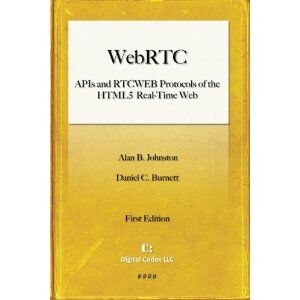It was only a matter of time until someone published a WebRTC Book. Here’s an interview with the author.
I even thought of doing it myself – publish a book about WebRTC. Not a “real” book – an eBook. Or a presentation. Maybe I’ll stick to posts. Alan B. Johnston and Daniel C. Burnett decided to publish a book and did just that. It is probably the first book about WebRTC.

The book is aptly titled “WebRTC: APIs and RTCWEB Protocols of the HTML5 Real-Time Web” and is available on Amazon.
If there’s anything missing today it is developers with enough experience with WebRTC. There aren’t a lot of them, and as far as I know, those that know something about WebRTC are already employed. This means that companies need to settle for either web developers or VoIP developers – and pray that they catch up on the technology. While there are good resources out there, you need to find them.
No more. The WebRTC Book is for developers – it covers the basics of VoIP, WebRTC and how to use it to develop… anything.

Alan Johnston, one of the authors of the book, was kind enough to answer a few questions for me now that the book is published:
Why a book about WebRTC?
WebRTC is an exciting technology that seems likely to be very disruptive to a number of industries. Having voice, video, and data communication capabilities built into every browser, and available for any web developer with just a few lines of JavaScript will change the web and the way we use it. There’s lot of interest in WebRTC, but also lots of confusion about what it is, how it works, and how developers can use it. Dan Burnett and I have been involved in the standardization of WebRTC from the beginning, in both the IETF and W3C. With the pieces starting to come together, we thought now was a good time to write a book about it.
Who is the target audience? Is this for web developers, who want to understand VoIP and WebRTC – or for VoIP developers, looking for understanding of WebRTC?
The nature of WebRTC is that it is about the collision of the web world and the telephony world. Web developers can use WebRTC to add cool new communication features to their sites and apps, while VoIP and telephony developers can use it as a new way to expand their reach.
We tried to write the book for both of these groups. In the book, we introduce the APIs used by JavaScript web developers, and the protocols used by VoIP and telephone developers.
And don’t forget game developers, or those wanting accessibility in their apps and sites, who will also find WebRTC incredibly useful.
WebRTC is a work in progress. As such, how did you cope with writing a book for developers about it?
It is challenging to write about a fast moving topic, but technology book publishing has always been this way. We had to wait until a majority of the details were fairly solid, but things will continue to develop and evolve.
Fortunately, we can take advantage of electronic publishing and print-on-demand technology to keep the book up-to-date. In the past, I have typically done new editions of my technical books every 3-4 years or so. For this WebRTC book, we plan to do this much more frequently, perhaps with multiple editions per year. And as more details are finalized, the book will grow and lengthen.
We also will post updates and changes in the standards and APIs to our book website http://webrtcbook.com.
You focus a lot in the book about connectivity to SIP and PSTN. Why is that?
The browser-to-browser communication model is fairly simple and straightforward, and we spend most of the book discussing these types of Peer Connections for voice, video, and data channels, and the APIs needed to do this. However, there is also a lot of interest in having browsers talk to VoIP endpoints, PSTN gateways, and other communication services. This gets a little more complicated, and we spend some time discussing architectures and protocols needed to do this.
What’s the most complex part in WebRTC?
We are still in the very early days of WebRTC rollout, so my answer to this now is likely to be different in a few months even. However, right now, it seems that the biggest challenge will be the offer/answer media negotiation between a browser and a VoIP or video endpoint. There is still quite a lot of discussion in the standards about the right way to do this. Fortunately, the average web developer doesn’t need to worry about this, but it is probably the most complex part.
What’s next for WebRTC in your view?
Well, we need to finish the standards, in both the W3C and the IETF.
Then we need to get the all the browser vendors to commit to supporting them. Any fragmentation or proprietary APIs or protocols would be bad for the whole industry. There are still some major open issues, such as video codec selection that need to be solved, and soon.
–
If you are a developer who wants to enter the world of WebRTC, or if you are a manager who needs to start developing with WebRTC, I highly recommend this book – it is the best starting point out there.
Get it now on Amazon.
